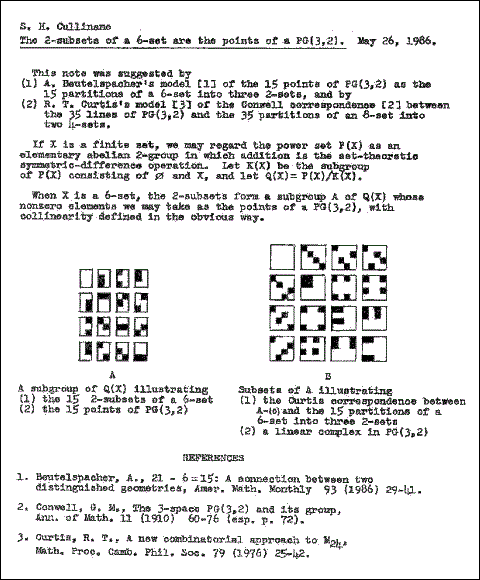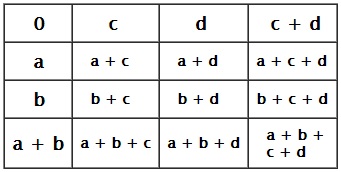For the former, see Warburg in this journal.
For the latter, see beadgame.space on the Web.
Wednesday, April 6, 2022
Programmes: Warburgian vs. Hessian
Sunday, November 1, 2020
Soul Sermon: Quick & Dirty Meets Fast & Furious
Friday, February 7, 2020
Correspondences
The 15 2-subsets of a 6-set correspond to the 15 points of PG(3,2).
(Cullinane, 1986*)
The 35 3-subsets of a 7-set correspond to the 35 lines of PG(3,2).
(Conwell, 1910)
The 56 3-subsets of an 8-set correspond to the 56 spreads of PG(3,2).
(Seidel, 1970)
Each correspondence above may have been investigated earlier than
indicated by the above dates , which are the earliest I know of.
See also Correspondences in this journal.
* The above 1986 construction of PG(3,2) from a 6-set also appeared
in the work of other authors in 1994 and 2002 . . .
-
Gonzalez-Dorrego, Maria R. (Maria del Rosario),
(16,6) Configurations and Geometry of Kummer Surfaces in P3.
American Mathematical Society, Providence, RI, 1994. -
Dolgachev, Igor, and Keum, JongHae,
"Birational Automorphisms of Quartic Hessian Surfaces."
Trans. Amer. Math. Soc. 354 (2002), 3031-3057.
Addendum at 5:09 PM suggested by an obituary today for Stephen Joyce:
See as well the word correspondences in
"James Joyce and the Hermetic Tradition," by William York Tindall
(Journal of the History of Ideas , Jan. 1954).
Tuesday, February 26, 2019
Citation
Some related material in this journal — See a search for k6.gif.
Some related material from Harvard —
Elkies's "15 simple transpositions" clearly correspond to the 15 edges of
the complete graph K6 and to the 15 2-subsets of a 6-set.
For the connection to PG(3,2), see Finite Geometry of the Square and Cube.
The following "manifestation" of the 2-subsets of a 6-set might serve as
the desired Wikipedia citation —
See also the above 1986 construction of PG(3,2) from a 6-set
in the work of other authors in 1994 and 2002 . . .
-
Gonzalez-Dorrego, Maria R. (Maria del Rosario),
(16,6) Configurations and Geometry of Kummer Surfaces in P3.
American Mathematical Society, Providence, RI, 1994. -
Dolgachev, Igor, and Keum, JongHae,
"Birational Automorphisms of Quartic Hessian Surfaces."
Trans. Amer. Math. Soc. 354 (2002), 3031-3057.

Friday, April 14, 2017
Hudson and Finite Geometry
The above four-element sets of black subsquares of a 4×4 square array
are 15 of the 60 Göpel tetrads , and 20 of the 80 Rosenhain tetrads , defined
by R. W. H. T. Hudson in his 1905 classic Kummer's Quartic Surface .
Hudson did not view these 35 tetrads as planes through the origin in a finite
affine 4-space (or, equivalently, as lines in the corresponding finite projective
3-space).
In order to view them in this way, one can view the tetrads as derived,
via the 15 two-element subsets of a six-element set, from the 16 elements
of the binary Galois affine space pictured above at top left.
This space is formed by taking symmetric-difference (Galois binary)
sums of the 15 two-element subsets, and identifying any resulting four-
element (or, summing three disjoint two-element subsets, six-element)
subsets with their complements. This process was described in my note
"The 2-subsets of a 6-set are the points of a PG(3,2)" of May 26, 1986.
The space was later described in the following —

Friday, September 16, 2016
A Counting-Pattern
Friday, January 17, 2014
The 4×4 Relativity Problem
The sixteen-dot square array in yesterday’s noon post suggests
the following remarks.
“This is the relativity problem: to fix objectively a class of
equivalent coordinatizations and to ascertain the group of
transformations S mediating between them.”
— Hermann Weyl, The Classical Groups ,
Princeton University Press, 1946, p. 16
The Galois tesseract appeared in an early form in the journal
Computer Graphics and Art , Vol. 2, No. 1, February 1977—
The 1977 matrix Q is echoed in the following from 2002—

A different representation of Cullinane’s 1977 square model of the
16-point affine geometry over the two-element Galois field GF(2)
is supplied by Conway and Sloane in Sphere Packings, Lattices and Groups
(first published in 1988) :
Here a, b, c, d are basis vectors in the vector 4-space over GF(2).
(For a 1979 version of this vector space, see AMS Abstract 79T-A37.)
See also a 2011 publication of the Mathematical Association of America —
Thursday, October 20, 2011
Bach and the Evening Star
This evening's New York Lottery numbers are 770 and 9703.
This suggests a look at post 770 (Hesse and Bach) and at 9/7/03 (Hesse and knights).
See also Hessian.
Saturday, January 8, 2011
True Grid (continued)
"Rosetta Stone" as a Metaphor
in Mathematical Narratives
For some backgound, see Mathematics and Narrative from 2005.
Yesterday's posts on mathematics and narrative discussed some properties
of the 3×3 grid (also known as the ninefold square ).
For some other properties, see (at the college-undergraduate, or MAA, level)–
Ezra Brown, 2001, "Magic Squares, Finite Planes, and Points of Inflection on Elliptic Curves."
His conclusion:
When you are done, you will be able to arrange the points into [a] 3×3 magic square,
which resembles the one in the book [5] I was reading on elliptic curves….
This result ties together threads from finite geometry, recreational mathematics,
combinatorics, calculus, algebra, and number theory. Quite a feat!
5. Viktor Prasolov and Yuri Solvyev, Elliptic Functions and Elliptic Integrals ,
American Mathematical Society, 1997.
Brown fails to give an important clue to the historical background of this topic —
the word Hessian . (See, however, this word in the book on elliptic functions that he cites.)
Investigation of this word yields a related essay at the graduate-student, or AMS, level–
Igor Dolgachev and Michela Artebani, 2009, "The Hesse Pencil of Plane Cubic Curves ."
From the Dolgachev-Artebani introduction–
In this paper we discuss some old and new results about the widely known Hesse
configuration of 9 points and 12 lines in the projective plane P2(k ): each point lies
on 4 lines and each line contains 3 points, giving an abstract configuration (123, 94).
PlanetMath.org on the Hesse configuration—

A picture of the Hesse configuration–

(See Visualizing GL(2,p), a note from 1985).
Related notes from this journal —
From last November —
|
From the December 2010 American Mathematical Society Notices—
Related material from this journal— Consolation Prize (August 19, 2010) |
From 2006 —
|
Sunday December 10, 2006
“Function defined form, expressed in a pure geometry
– J. G. Ballard on Modernism
“The greatest obstacle to discovery is not ignorance –
— Daniel J. Boorstin, |
Also from 2006 —
|
Sunday November 26, 2006
Rosalind Krauss "If we open any tract– Plastic Art and Pure Plastic Art or The Non-Objective World , for instance– we will find that Mondrian and Malevich are not discussing canvas or pigment or graphite or any other form of matter. They are talking about Being or Mind or Spirit. From their point of view, the grid is a staircase to the Universal, and they are not interested in what happens below in the Concrete. Or, to take a more up-to-date example…."
"He was looking at the nine engravings and at the circle,
"And it's whispered that soon if we all call the tune
The nine engravings of The Club Dumas
An example of the universal*– or, according to Krauss,
"This is the garden of Apollo, the field of Reason…."
For more on the field of reason, see
A reasonable set of "strange correspondences" Unreason is, of course, more popular. * The ninefold square is perhaps a "concrete universal" in the sense of Hegel: "Two determinations found in all philosophy are the concretion of the Idea and the presence of the spirit in the same; my content must at the same time be something concrete, present. This concrete was termed Reason, and for it the more noble of those men contended with the greatest enthusiasm and warmth. Thought was raised like a standard among the nations, liberty of conviction and of conscience in me. They said to mankind, 'In this sign thou shalt conquer,' for they had before their eyes what had been done in the name of the cross alone, what had been made a matter of faith and law and religion– they saw how the sign of the cross had been degraded."
– Hegel, Lectures on the History of Philosophy ,
"For every kind of vampire, |
And from last October —
|
Friday, October 8, 2010
Starting Out in the Evening This post was suggested by last evening's post on mathematics and narrative and by Michiko Kakutani on Vargas Llosa in this morning's New York Times .
"One must proceed cautiously, for this road— of truth and falsehood in the realm of fiction— is riddled with traps and any enticing oasis is usually a mirage."
– "Is Fiction the Art of Lying?"* by Mario Vargas Llosa,
* The Web version's title has a misprint— |
Thursday, April 19, 2007
Thursday April 19, 2007
On April 19, 1775, troops under the command of Brigadier General Hugh Percy played "Yankee Doodle" as they marched from Boston to reinforce British soldiers already fighting the Americans at Lexington and Concord. Whether sung or played on that occasion, the tune was martial and intended to deride the colonials:
Yankee Doodle came to town,
For to buy a firelock;
We will tar and feather him
And so we will John Hancock.
(CHORUS)
Yankee Doodle, keep it up,
Yankee Doodle Dandy,
Mind the Music and the step,
And with the girls be handy.
There are numerous conflicting accounts of the origin of "Yankee Doodle." Some credit its melody to an English air, others to Irish, Dutch, Hessian, Hungarian and Pyrenean tunes or a New England jig….
"Yankee Doodle" was well known in the New England colonies before Lexington and Concord but only after the skirmishes there did the American militia appropriate it. Tradition holds that the colonials began to sing it as they forced the British back to Boston on April 19, 1775, after the battles of Lexington and Concord. It is documented that the Americans sang the following verse at Bunker Hill:
Father and I went down to camp,
along with Captain Good'in,
And there we see the men and boys
as thick as hasty puddin'.
"Thanks to you, I die like Jesus Christ, to inspire generations of the weak and the defenseless people.''
"It's not for me. For my children, for my brothers and sisters… I did it for them.''

Eureka!














